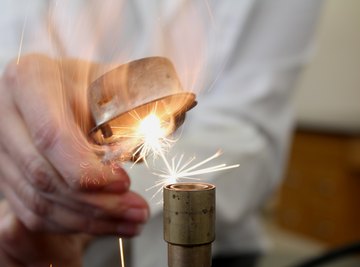
The difference between heat and temperature can be a difficult concept to grasp. Essentially, heat is the total amount of kinetic energy the molecules of a substance have, and is measured in units of joules (J). Temperature is related to the average kinetic energy of the individual molecules, and is measured in degrees. Applying the same amount of heat to different materials will result in different levels of temperature increases, depending on the specific heat capacity of the substance. You can calculate the final temperature if you know the quantity of the substance and its specific heat capacity.
- Calculator
- Chemical substance
A useful way to remember the difference between heat and temperature is that a bathtub of hot water would provide more heat on a cold winter day compared to a drop of molten steel, even though the temperature of the steel is much higher.
Divide the amount of heat energy provided to the substance, in joules, by the mass of the substance, in grams (g). For example, if 4,000 joules of energy were provided to 500 g of water, you would calculate 4,000/500 = 8.
Divide the result of the previous calculation by the specific heat capacity of the substance. You can generally obtain the specific heat capacity of a chemical substance from the manufacturer's literature or from a scientific reference source such as the CRC Handbook of Chemistry and Physics. The result of this calculation is the temperature increase of the substance, in units of degrees Celsius. The specific heat capacity of water is g/4.19 J - degrees Celsius. In the example the calculation would be 8/4.19 = 1.9 degrees Celsius.
Add the temperature increase just derived to the substance. This gives you the temperature after the heat input. If the water in the example had initially been at 25 degrees, its temperature after heating would be 25 + 1.9 = 26.9 degrees Celsius.
Add 273.1 to the final temperature of the substance that was just calculated. This is the conversion factor to change from units of degrees Celsius to Kelvin (K). The result is the temperature of the material after the heat input in kelvins. The water temperature would be 26.9 + 273.1 = 300 K.
Things You'll Need
Tips
References
Tips
- A useful way to remember the difference between heat and temperature is that a bathtub of hot water would provide more heat on a cold winter day compared to a drop of molten steel, even though the temperature of the steel is much higher.
About the Author
Michael Judge has been writing for over a decade and has been published in "The Globe and Mail" (Canada's national newspaper) and the U.K. magazine "New Scientist." He holds a Master of Science from the University of Waterloo. Michael has worked for an aerospace firm where he was in charge of rocket propellant formulation and is now a college instructor.
